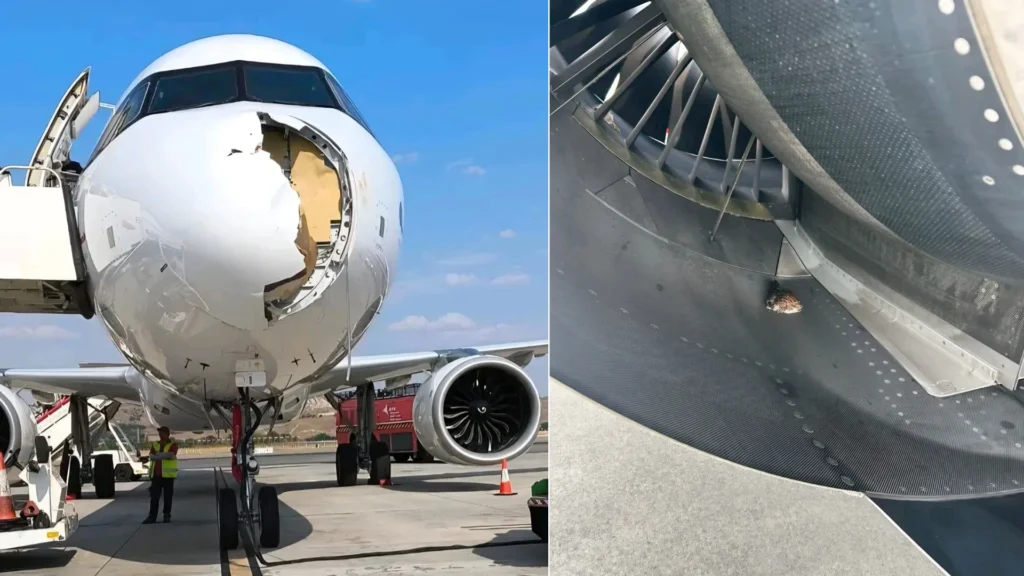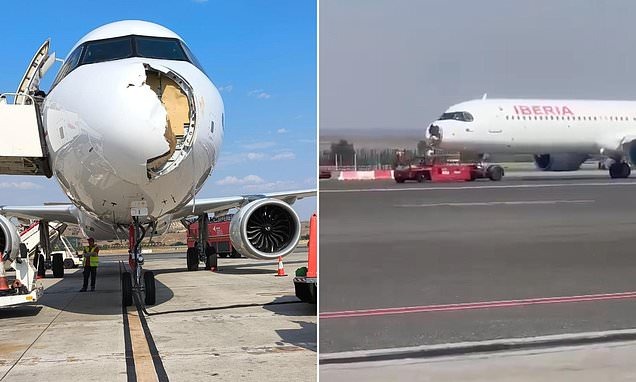Emergency Landing After Takeoff from Madrid
On August 3, 2025, an Iberia flight from Madrid to Paris was forced to make an emergency return shortly after takeoff due to a serious bird strike. The incident involved an Airbus A321-253NY, which took off from Adolfo Suárez Madrid–Barajas Airport but had to land less than an hour later after the aircraft sustained significant damage to its nose section — the location of the weather radar system.
According to aviation sources, the aircraft was struck by a large bird mid-air, resulting in visible tearing of the nose cone. Airport photos revealed the damage, and reports confirmed that another bird was found lodged in one of the plane’s engines during the post-flight inspection.

What Is a Bird Strike and Why Is It Dangerous?
A bird strike occurs when a bird or flock of birds collides with an aircraft in flight. While birds may seem harmless, at cruising or takeoff speeds — which can exceed hundreds of kilometers per hour — even a small bird can cause serious mechanical or structural issues. The danger is higher during takeoff and landing when planes fly at lower altitudes, where birds are most likely to be present.
Critical areas such as engines, cockpits, windshields, and nose cones are especially vulnerable. In this case, the aircraft’s radar equipment housed in the nose was reportedly compromised, making continued flight unsafe.
Aircraft and Passenger Safety Procedures Followed
Following standard aviation safety protocols, the flight crew promptly declared an emergency and coordinated with air traffic control to return to Madrid. The plane landed safely without incident, and no injuries were reported among the passengers or crew on board.
Iberia, Spain’s national airline, conducted a full technical evaluation of the aircraft following the event. Flight services between Madrid and Paris continued with alternate aircraft while the damaged plane was removed from active service for inspection and repair.

Bird Strikes: A Global Aviation Hazard
Bird strikes are not uncommon in global aviation. The Federal Aviation Administration (FAA) in the United States estimates that wildlife strikes, primarily involving birds, result in nearly $900 million in damages annually. Since 1990, the number of reported bird strike incidents has increased significantly, reaching more than 10,000 cases in some years.
Airports and airlines worldwide continuously work to mitigate this risk through several preventive measures. These include wildlife management programs, specialized bird detection radar systems, and modifications to airfield environments to make them less attractive to birds.

Preventive Measures in Place
Modern airports use a variety of bird deterrent technologies and strategies. These include:
-
Audio deterrents (e.g., distress calls)
-
Laser deterrents
-
Habitat modification (removing standing water or food sources)
-
Scheduled wildlife patrols
-
Bird detection radar to alert pilots of bird activity
While these efforts help reduce risk, complete prevention is not always possible. Airlines rely on their crews’ training and aircraft safety protocols to respond quickly and effectively when such incidents occur.

Iberia’s Response and Commitment to Safety
In a statement, Iberia emphasized its commitment to passenger safety and confirmed that all necessary protocols were followed during and after the incident. The airline is cooperating fully with maintenance teams and aviation safety authorities to investigate the bird strike and assess the aircraft’s condition.
The Airbus A321-253NY is part of Iberia’s newer fleet and is equipped with advanced safety and navigation systems. Despite the damage, the safe return of the aircraft and the absence of injuries highlight the effectiveness of modern aviation protocols in emergency situations.
Summary
On August 3, 2025, an Iberia Airbus A321 traveling from Madrid to Paris made an emergency landing after a bird strike caused significant damage to the aircraft’s nose. No injuries were reported, and the aircraft returned safely to Madrid. Bird strikes remain a serious aviation concern globally, and airports continue to develop strategies to minimize these risks. Iberia followed standard safety procedures and is currently conducting a full technical review.
